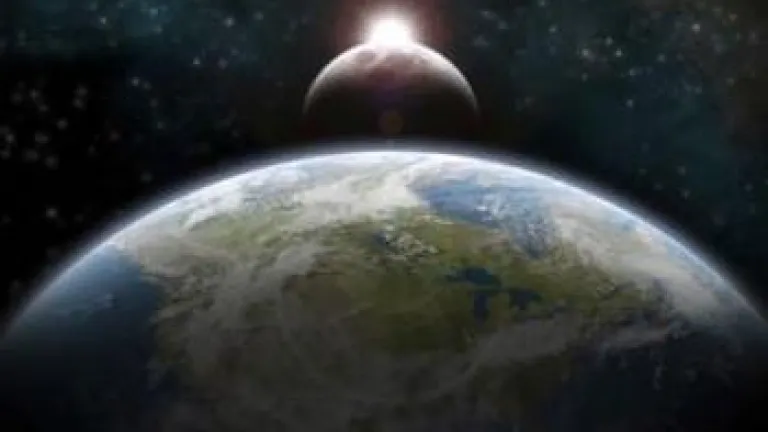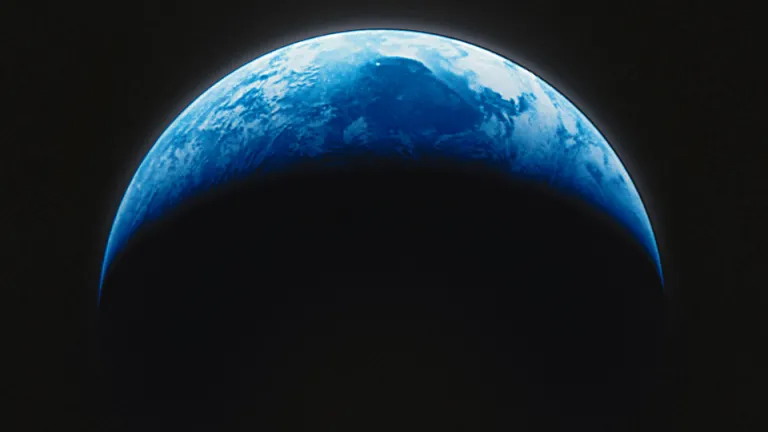Venus: What Science & the Bible Tell Us About this Fascinating Planet

Venus has been called the “jewel of the sky” and “Earth’s sister planet.” The more I learn about Venus, the more amazed and inspired I am! The special cyclical relationships between Venus and Earth are like an intricate but graceful dance! God gave our solar system a complex and beautiful design!
I don’t know much about astronomy but I’ve been learning a tiny bit lately about the four “terrestrial” (solid, rocky) planets. Going away from the Sun, their orbits are in this order: Mercury, Venus, Earth, Mars. The few facts I’ll mention are like a grain of sand on the beach of modern knowledge—knowledge greatly expanded since 1962 by discoveries using exploratory space missions, primarily by Russia and the United States. There are several large books on the market just about Venus and there is a wealth of information on the Internet.
Venus is about the same size as Earth and is our closest planetary neighbor. But our twin is very different! Whereas the mean surface temperature of Earth is about 72 degrees Fahrenheit, the mean surface temperature of Venus is 870 degrees! Venus’s atmosphere is mostly carbon dioxide with thick yellow-white clouds of sulfuric acid. These clouds, partly the result of active volcanoes, are largely responsible for the high heat because of their “greenhouse effect” on the incoming energy from the Sun. Venus is hotter than Mercury even though it is twice as far from the Sun as Mercury.
The atmospheric pressure on Venus’s surface is 92 times that of Earth! That is about the same pressure as being one kilometer (3,281 feet) deep under water. If we were to suddenly be on Venus, we would be instantly squashed and burned!
Venus experiences a constant, high-speed wind that carries its clouds on a complete trip around the planet every four Earth days!
Venus orbits the Sun relatively quickly—in about 225 earth-days as compared to Earth’s orbit of about 365 days. But Venus rotates on its axis so slowly that it takes 243 earth-days to make one rotation. Therefore one “Venus day” is longer than a “Venus year”! And Venus revolves in the opposite direction from all the other planets in our solar system except Uranus—on Venus and Uranus, the sun rises in the west and sets in the east!
The periods of Venus as “Evening Star” and “Morning Star” each average about 263 days. In between, Venus disappears from our view on the near side of the sun for about 8 days, and it disappears from our view on the far side of the sun for about 50 days, for a total of 584 days for the entire cycle.
Why is Venus so bright?
Venus is the third brightest luminary in our sky—only the Sun and the Moon are brighter. For long periods of time, Venus is bright enough to cast shadows on Earth. Venus’s cloud covering is highly reflective—reflecting about 70 percent of incoming sunlight back into space. That’s part of the reason for Venus’s brightness. The other primary reason is its closeness to Earth.
Venus has phases like the Moon has phases. It waxes (grows larger in appearance) and wanes (diminishes in appearance). Hence there are the phases of full Venus, half Venus, quarter Venus, crescent Venus, etc. What is surprising is that Venus appears to us earthlings to be its brightest when its phase is a quarter or less! How can that be?
Here is the answer: Venus appears brighter as it gets closer to Earth. When Venus is “full,” it is on the opposite side of the Sun, the farthest possible distance from Earth. As the orbits of Earth and Venus bring them closer together (more and more on the same side of the Sun), Venus appears brighter—even when we are seeing only a “quarter Venus” or less!
My interest in Venus has been kindled because this “Evening Star” has been especially bright in this April and May of 2012.
Earth will soon see a “Venus Transit”!
A Venus Transit occurs when we can see Venus passing directly in front of the Sun. This is similar to when the Moon passes in front of the Sun on a solar eclipse. Unlike the Moon, which covers most of the Sun, Venus appears as a small dot crossing the face of the Sun. A transit (sometime called a passage) can only occur with the inner planets—Mercury and Venus—because they are the only two that can lie between the Earth and Sun during their orbits.
We are in the midst of the first Venus Transit of this millennium. Venus Transits usually come in pairs, with each transit in the pair spaced eight years apart. There was a transit on June 8, 2004 and the next one will be on June 5-6, 2012. In North America, it will take place on the late afternoon and evening of June 5th. (Don’t look at the Sun trying to see the Transit unless you are using the right type of protective goggles.)
This pair of Venus Transits is a rare once-in-a-lifetime event. The last Venus Transit pairs occurred in 1874 and 1882. The next pair will occur in 2117 and 2125.
Venus and paganism
Venus has the shameful “honor” of being named after a pagan goddess (Venus was the Roman goddess of beauty and love). Several ancient civilizations practiced Venus worship, and veneration of the planet has persisted even into modern times.
The English word “Friday” is derived from the Anglo-Saxon Frigedaeg, meaning “Venus day” (Friga = Venus + dae = day), and many other languages also trace their names for Friday from root words meaning “Venus day.” The Spanish name for Friday is viernes.
God, Jesus Christ and metaphors
The Bible has many metaphors (symbolic word-pictures) for God and Jesus Christ. Jesus Himself said I am the bread of life, the light of the world, the door, the good shepherd and the true vine. All these metaphors give us meaningful insight into the many different aspects of the character, roles and relationships of Christ.
A significant related point is that when we read in the Old Testament about God appearing and speaking to people, that was the Word, the One who later was known as Jesus Christ after He came to Earth for His earthly ministry. Many, many scriptures corroborate this truth. For example, see John 1:1-18; John 5:37; 1 Corinthians 10:4; 1 John 4:12. For thorough proof of this truth, see our booklet Who Is God?
We see that using metaphors for God is fine, but the Second Commandment forbids making any physical images to represent God (Exodus 20:4-6). This also means that we must not incorporate visual images of God into our worship of God.
One metaphor for God is the Sun (Psalm 84:11; Malachi 4:2). It’s quite meaningful because the sun is the physical light of the world while Christ (and His true disciples) are the spiritual lights of the world (John 8:12; 9:5; Matthew 5:14). But both sun-worship and representing God with images of the Sun are inexcusable and abominable in God’s sight because they violate both the First and Second Commandments.
We can also say that a metaphor for God is a star because our Sun is a star. A star is a hot sphere that generates light whereas a planet merely reflects light from stars. Incidentally, the saints who are resurrected to be in God’s kingdom are also compared with stars in their glory (Daniel 12:3; 1 Corinthians 15:40-42).
Venus and Jesus Christ
In Numbers 22-24 is the account of King Balak summoning Balaam, a pagan prophet, to curse Israel. However, Balaam could only pronounce what God allowed him to say or what God forced him to say.
In Balaam’s fourth “oracle” (prophecy), he said, “I see Him, but not now; I behold Him, but not near; a Star shall come out of Jacob; a Scepter shall rise out of Israel, and batter the brow of Moab, and destroy all the sons of tumult” (Numbers 24:17).
Regarding this verse, the Nelson Study Bible says, “This poetic language clearly refers to the Messiah. The pagan Balaam had a vision of the coming of the Hebrew Messiah, the Lord Jesus Christ! He was visible from afar. He was like a Star, radiant and beautiful. He was like a Scepter, majestic and powerful.”
Now notice Revelation 22:16, which says, “I, Jesus, have sent My angel to testify to you these things in the churches. I am the Root and the Offspring of David, the Bright and Morning Star.”
So we see that the planet Venus is a metaphor for Jesus Christ! Balaam’s prophecy will be wholly fulfilled with the second coming of Christ!
The Bible uses the word “star” to refer to any bright object in the sky other than the Sun and Moon. The word “planet” is not in the Bible, so the Bible does not distinguish between planets and true stars.
All of God’s creation should remind us of the Creator (Romans 1:20-21). Now we have seen specifically that Venus should remind us of Christ.
We are in the pre-dawn light before the sunrise of Christ’s coming!
The earthly ministry of Jesus Christ introduced the pre-dawn light of the world (Luke 1:78-79; John 8:12; Matthew 4:13-16; 2 Corinthians 4:6).
Now that Jesus has returned to heaven, His followers are commissioned to bring light to the world (Matthew 5:14-16; Ephesians 5:8). Only God and Christ are the source of light, like stars are sources of physical light. God’s people are to be like planets and moons that reflect the light of God. While they live “in the midst of a crooked and perverse generation,” they are to “shine as lights in the world” (Philippians 2:15).
In Matthew 24:14, Jesus said, “And this gospel of the kingdom will be preached in all the world as a witness to all the nations, and then the end will come.” Jesus made it clear that the light of God’s truth would be powerfully preached and published in the years preceding Christ’s return. “The darkness is passing away, and the true light is already shining” (1 John 2:8).
In the New Living Translation, the latter half of 2 Peter 1:19 says, “You must pay close attention to what they [the prophets] wrote, for their words are like a lamp shining in a dark place—until the Day [Day of the Lord] dawns, and Christ the Morning Star shines in your hearts.” So we see that the Bible uses both the appearance of the Morning Star and the sunrise to picture the return of Christ.
As the pre-dawn light becomes brighter and brighter, excitement is building in anticipation of the spectacular “sunrise” of Christ’s second coming!
God, speaking through Malachi, said, “But to you who fear My name the Sun of Righteousness shall arise with healing in His wings; and you shall go out and grow fat like stall-fed calves” (Malachi 4:2). That’s a prophecy of Christ’s return and the joyous resurrection of the saints!
One last lesson: As the dawn approaches, it’s urgent for those who are spiritually asleep to awaken and be prepared for the new day of Christ’s glorious reign on earth (Romans 13:11-14; 1 Thessalonians 5:1-8).




